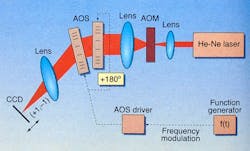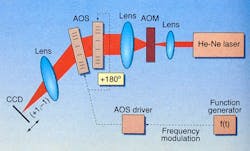Researchers from the Weizmann Institute of Science (Rehovot, Israel) have produced an acousto-optic focal scanner that can operate at 400 kHz and, in its initial form, operate over a focusing range from 120 to 180 mm. The team used a one-dimensional (cylindrical) version of the dynamic lens, but researchers say that two-dimensional (spherical) and even three-dimensional systems should be possible.
The refractive index of an acousto-optic (A-O) crystal changes when it is subjected to compression (sound) waves. Commercial devices work by having the sound wave travel down the crystal's length, with the crests of the waves increasing the index and the troughs reducing it, thus producing planes of constant refractive index. To a laser beam entering from from the side, this looks like a very thick, and therefore efficient, transmission hologram or diffraction grating, but one that is moving very fast. For this reason, A-O devices are best known as scanners.
The changing refractive index can, however, also produce aberrations: when the frequency of the sound wave changes (chirping), a cylindrical lensing effect occurs. Essentially, the chirp changes the A-O crystal from looking like a grating to acting like a one-dimensional Fresnel lens. This is not a problem in conventional applications in which the desired scan—and so the frequency—is linear. For nonlinear applications, on the other hand—such as creating optical traps for ultracold atoms, or stirring or rotating Bose-Einstein condensates—the aberrations cause problems. To keep aberrations tolerably low, the lensing effect (and frequency chirp) must be kept to a minimum. The only way to do that previously had been to run the nonlinearities through the modulator very slowly, thus restricting the overall speed of the system.
Last year, Nir Friedman, Ariel Kaplan, and Nir Davidson showed that the unwanted lensing effects could be removed by using counterpropagating beams, with the system performing only the desired task of a transverse nonlinear scan.1 Now, in a project lead by Kaplan, the team has figured out a way to do the opposite, removing the transverse scanning so that only the focal length varies.2
In the new system, two crystals are used (see figure). The same frequency-modulated sound waves propagate down each one in opposite directions, but with a phase change between the two. The counterpropagating refractive-index modulations have the effect of scanning the beam in opposite directions: hence, the movement of one is canceled out by the other. In addition, the phase difference between the two means that the maximum difference in optical path length the laser beam experiences is doubled, thus increasing the focal-length variation.
REFERENCES
- Nir Friedman et al., Opt. Lett. 25 (24), 1762, (Dec. 15, 2000).
- Ariel Kaplan et al., Opt. Lett. 26 (14), 1078, (July 15, 2001).

